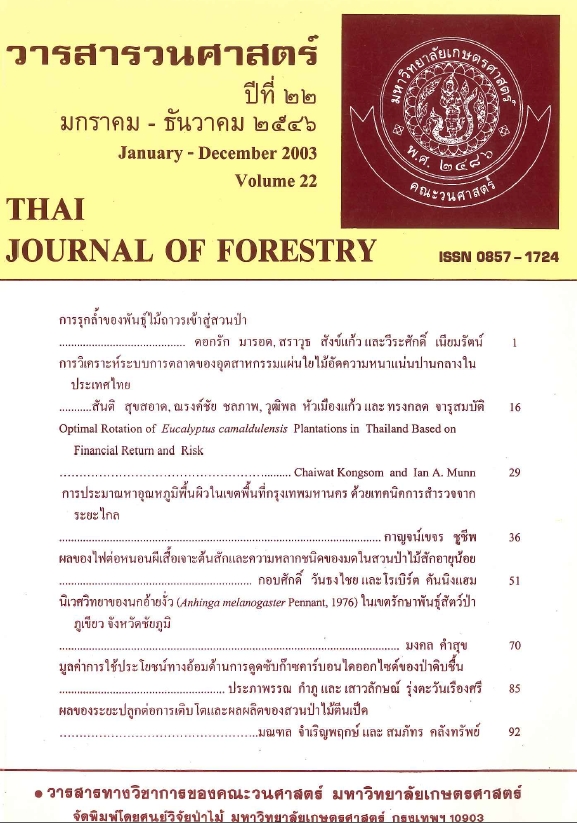นิเวศวิทยาของนกอ้ายงั่ว (Anhinga melanogaster Pennant, 1769) ในเขตรักษาพันธุ์สัตว์ป่าภูเขียว จังหวัดชัยภูมิ
Main Article Content
บทคัดย่อ
การศึกษานิเวศวิทยาของนกอ้ายงั่วในเขตรักษาพันธุ์สัตว์ป่าภูเขียว จังหวัดชัยภูมิ ศึกษาระหว่างเดือนเมษายน พ.ศ. 2541-เมษายน พ.ศ. 2542 เพื่อศึกษาพฤติกรรม ถิ่นอาศัย ชนิดอาหาร จำนวนประชากร ปัญหา และแนวทางจัดการนกอ้ายงั่ว ผลการศึกษาพบว่านกอ้ายงั่วเป็นนกน้ำขนาดใหญ่ใช้เวลาส่วนใหญ่ในรอบวันเกาะคอนพักผ่อนบนต้นไม้แห้งริมหรือในแหล่งน้ำ ในวันที่อากาศร้อนจัดมักใช้คอนต้นไม้ที่มีใบปกคลุมหนาแน่น หาอาหารโดยการดำน้ำตามบริเวณ โดยรอบพืชลอยน้ำในแหล่งน้ำนิ่ง ตั้งแต่ความลึก 0.9-1.7 เมตร มากกว่าระคับหากินอื่นๆ ช่วงเวลาหาอาหารมี 3 ช่วง คือ ช่วงเช้ามืดก่อน 07.00 น. ช่วงสาย 10.00 -12.00 น. และช่วงบ่าย 13.30-16.00 น. หาอาหารแต่ละครั้งใช้เวลาตั้งแต่ 6 นาที จนถึง 3 ชั่วโมง 21 นาที เฉลี่ย 1 ชั่วโมง 7 นาที ใช้ระยะทางว่ายและดำตั้งแต่ 10-200 เมตร เฉลี่ย 162.5 เมตร/ครั้ง การจิกและกินเหยื่อมี 2 แบบ คือ ใช้ปากคาบหรือใช้จะงอยปากจิ้มแทงทะลุตัวเหยื่อแล้วโยนขึ้นในอากาศก่อนอ้าปากรับแล้วกลืนกินทั้งตัว โดยเอาด้านหัวเหยื่อเข้าก่อน ชนิดเหยื่อเป็นปลาขนาดเล็ก ส่วนใหญ่อยู่ในวงศ์ปลาตะเพียน (Family Cyprinidae) เมื่อเสร็จสิ้นการหาอาหารแล้วจะตากหรือผึ่งปีกบนตอไม้ปริ่มน้ำจนถึงต้นไม้แห้งสูง 30 เมตร การตากหรือผึ่งปีกใช้เวลาตั้งแต่ 5 นาที จนถึง 1 ชั่วโมง 7 นาที เฉลี่ย 20.07 นาที/ครั้ง มีประชากรอย่างน้อย 2 ตัว คาดว่าเป็นนกอพยพสร้างรังระหว่างตอนเหนือกับตอนกลางของประเทศไทยหรือตอนเหนือกับตอนกลางของอินโดจีนการปรากฏของนกอ้ายงั่วในรอบปีแปรผันโดขตรงกับอุณหภูมิ โดยอพยพออกเมื่ออุณหภูมิลดต่ำลงและอพยพกลับเมื่ออุณหภูมิปกติ ไม่มีพฤติกรรมก้าวร้าวกับสัตว์ป่าที่ใช้แหล่งน้ำเดียวกัน ยกเว้นกับนกชนิดเดียวกันเท่านั้น ไม่พบพฤติกรรมเกี้ยวพาราสี ผสมพันธ์ สร้างรังวางไข่ และเลี้ยงถูกอ่อน สถานภาพของนกอ้ายงั่วเป็นสัตว์ป่าคุ้มครองตาม พ ร .บ. สงวนและคุ้มครองสัตว์ป่า พ.ศ. 2535 เป็นสัตว์ป่าที่ใกกัจะสูญพันธุ์อย่างยิ่ง ตามการจัดสถานภาพทรัพยากรชีวภาพของประเทศไทย และขัดเป็นสัตว์ที่ถูกคุกคามตามสมุดปกแดงของ IUCN (196)
Downloads
Article Details

อนุญาตภายใต้เงื่อนไข Creative Commons Attribution-NonCommercial-NoDerivatives 4.0 International License.
ข้าพเจ้าและผู้เขียนร่วม (ถ้ามี) ขอรับรองว่า ต้นฉบับที่เสนอมานี้ยังไม่เคยได้รับการตีพิมพ์และไม่ได้อยู่ในระหว่างกระบวนการพิจารณาตีพิมพ์ลงในวารสารหรือสิ่งตีพิมพ์อื่นใด ข้าพเจ้าและผู้เขียนร่วม (ถ้ามี) ยอมรับหลักเกณฑ์และเงื่อนไขการพิจารณาต้นฉบับ ทั้งยินยอมให้กองบรรณาธิการมีสิทธิ์พิจารณาและตรวจแก้ต้นฉบับได้ตามที่เห็นสมควร พร้อมนี้ขอมอบลิขสิทธิ์ผลงานที่ได้รับการตีพิมพ์ให้แก่วารสารวนศาสตร์ คณะวนศาสตร์ มหาวิทยาลัยเกษตรศาสตร์ กรณีมีการฟ้องร้องเรื่องการละเมิดลิขสิทธิ์เกี่ยวกับภาพ กราฟ ข้อความส่วนใดส่วนหนึ่ง หรือ ข้อคิดเห็นที่ปรากฏในผลงาน ให้เป็นความรับผิดชอบของข้าพเจ้าและผู้เขียนร่วม (ถ้ามี) แต่เพียงฝ่ายเดียว และหากข้าพเจ้าและผู้เขียนร่วม (ถ้ามี) ประสงค์ถอนบทความในระหว่างกระบวนการพิจารณาของทางวารสาร ข้าพเจ้าและผู้เขียนร่วม (ถ้ามี) ยินดีรับผิดชอบค่าใช้จ่ายทั้งหมดที่เกิดขึ้นในกระบวนการพิจารณาบทความนั้น”


